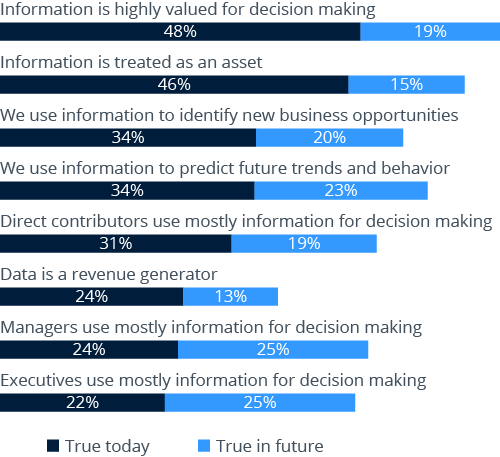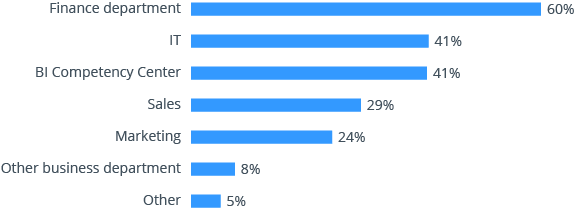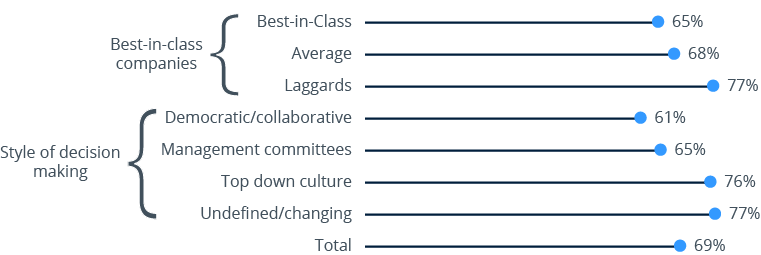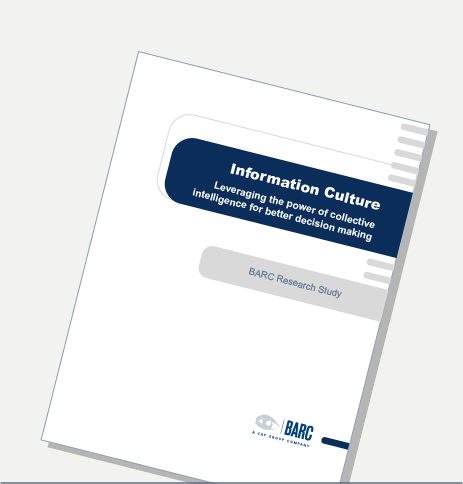
Statements on information culture: True today and true in future (n=728)
The value and benefit of information
Less than 50% of companies agree that information is highly valued for decision-making or treated as an asset in their organization today, but two-thirds believe it will be in the future.
Only one-third of enterprises currently use information to identify new business opportunities and predict future trends and behavior, but most of the remaining two-thirds plan to do so in the future.
Businesses with a collaborative style of decision-making treat information much more as an asset than companies with other decision-making approaches. They are also more likely to use information to identify new business opportunities, predict future trends and behavior or generate revenue with data.
Using information or gut feel for decision-making
58% of respondents say their companies base at least half of their regular business decisions on gut feel or experience rather than being driven by data and information.
Significantly fewer best-in-class companies than laggards base the majority of their business decisions on gut feel or experience (40% vs. 70%). This highlights a link between using information for decision-making and being able to benefit from information and achieve a strategic advantage over rivals.
On average, organizations only use 50% of all available information for decision-making.
What prevents organizations from making data-driven decisions?
The most commonly cited reason for not using information as the basis for decision-making is that the necessary information was not available.
The quality of data is the second biggest barrier to data-based decision-making. This reflects a clear need for greater attention to data quality and more efficient data governance. Because 62% of companies want to treat information as an asset in the future, it is critical that organizations invest in protecting the quality and value of that asset.
Call for action: How to achieve a data-driven business culture and benefit from it
50% of all decisions in businesses are based on information, and only half of the available information in organizations is actually used for decision-making. In order to unlock the potential of the remaining data, the following needs to be done:
- Address and improve data quality
- Lower the cost of access to information
- Improve the way in which information is presented
- Make information easier to find
- Increase the speed at which information is made available
- Raise awareness of business intelligence at senior management levels; and
- Foster a collaborative style of decision-making.
Data: the key requirement for a successful data-driven business culture
Where does data for decision-making come from?
Overall, the median number of internal data sources used to support decision-making is 5, so most companies are dealing with multiple sources. The goal of having only one source, such as an enterprise data warehouse, has been achieved by only 6% of respondents. Integrating external data sources is also quite common: the mean number is three external sources.
Around a half of all respondents think that the number of data sources they use is increasing. The growth rate for external sources is a bit higher than that for internal data sources.

Who manages and governs data for decision-making? (n=726)
Who governs data?
The finance department is cited by 60% of respondents as playing a prominent role in data management and governance.
41% say that IT departments manage and govern data although only 10% state that the IT department alone is responsible for this. We would be concerned if the latter figure were any higher than this.
Business Intelligence Competency Centers (BICCs) are much more likely to take responsibility in best-in-class companies (52%) compared to average companies (40%) and laggards (28%).
Defining and using standard KPIs
79% of respondents have a defined, standard set of KPIs in their organization, but only 36% are using them pervasively across the organization. This is obviously a major issue and an area for improvement for data-driven decision-making.
Best-in-class companies rely on defined and pervasively used KPIs much more than average and laggard companies.
Call for action: How to improve data governance
Companies source data for decision-making from an increasing number of internal and external data sources, but data governance remains a major issue. To better govern the data and systems involved in decision-making, enterprises should do the following:
- Build an agile IT architecture that can integrate an increasing number of data sources required for decision-making, as well as external and non-transactional (big data) sources.
- Set up (or strengthen) bodies to drive cross-departmental alignment for data governance and other BI-related tasks. BI Competency Centers (BICCs) and BI Centers of Excellence (BI CoEs) can play a key role in improving cross-departmental alignment for data governance and data-driven decision-making in general.
- Define and pervasively use KPIs across the organization to achieve a common foundation for decisions, align measures of success and focus data governance on important data.
Collaboration improves overall performance
Decision culture determines information culture
Top-down is the dominant style of decision-making with 39% of companies employing it, followed by 34% of organizations run by management committees and only 18% making decisions in a democratic or collaborative fashion.
69% of respondents think their company would perform better with a greater level of participation and collaboration.
The more collaborative the decision-making approach, the more likely people are to classify their company as best-in-class. On the flip side, respondents from companies with a predominantly top-down culture feel they are lagging behind the competition in using data for competitive advantage.

Percentage of respondents saying their company would perform better with more collaborative decision-making (total and by best-in-class, style of decision-making) (n=692)
How people collaborate
Direct, personal interactions via in-person meetings (88%) and conference calls/web meetings (68%) are two of the three most popular ways to collaborate. Using IT to collaborate is done primarily by e-mail (82%) while all other software-based approaches are much less popular.
Concerning business software, BI tools are used more often for collaboration than Microsoft Sharepoint, dedicated collaboration tools or other software.
Our sample sees little value in collaboration for reporting. However, more than two-thirds of respondents agree that collaboration adds value where data analysis or planning and forecasting is concerned.
Call for action: How to use collaboration to improve performance
- Move from top-down to a more democratic style of decision-making to increase participation and collaboration.
- Add software-based approaches to traditional methods of collaboration, such as in-person meetings and conference calls.
- Use BI tools to improve collaboration in data-driven decision-making.
- Increase collaboration in data analysis and planning processes – two key areas for improvement.
Conclusion
The results of this study clearly show that improving data-driven decision-making in volatile environments depends on information technology to integrate, store and present data to decision-makers. But even the best data management concepts, tools, and applications cannot be effective when the inherent culture of an organization prevents information from being treated as an asset and used as a valued resource. Best-in-class companies place a greater emphasis on basing decisions on data rather than gut feel, on governing their data and on fostering collaborative/democratic decision styles more often than others to achieve an information culture that turns information into a competitive advantage.
Information Culture Report
Leveraging the power of collective intelligence for better decision making
Request the free report now





